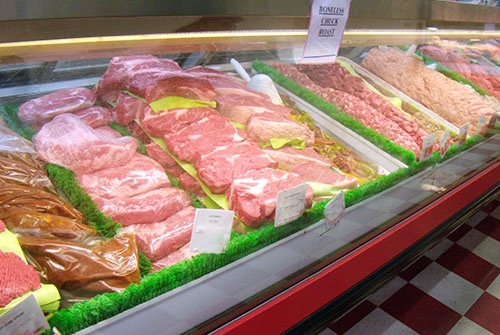Discover the Local Flavor at Bagley Farms Meat Market Edwardsville IL: Fresh and Delicious
Discover the Local Flavor at Bagley Farms Meat Market Edwardsville IL: Fresh and Delicious
Blog Article
Uncover the Art of the Butcher's Cut in a Modern Meat Market
In the ever-evolving landscape of modern-day meat markets, the butcher's cut has actually transcended its conventional origins, merging age-old craftsmanship with modern techniques. What really establishes the contemporary butcher apart is their capability to forge a deeper link between customers and the beginnings of their meat.
Evolution of Butchery Methods
The development of butchery strategies shows a rich tapestry of innovation and adaptation driven by improvements in technology, adjustments in consumer demand, and a much deeper understanding of meat scientific research. Historically, butchery was a craft passed down via generations, with approaches sharpened over centuries to take full advantage of yield and flavor. The industrial transformation ushered in automation, changing typical methods and allowing large handling.
The mid-20th century saw butchery methods better improved by clinical insights into muscle biology and meat aging, improving both tenderness and taste. Innovations like vacuum cleaner product packaging and refrigeration prolonged product shelf-life, enabling butchers to expand offerings and boost high quality control. This period likewise marked the rise of specific equipment, such as band saws and meat slicers, which boosted precision and effectiveness in meat handling.

Electronic systems now help in tracking animal provenance and enhancing cuts to meet details consumer preferences. Additionally, a rebirth in artisanal butchery has arised, blending standard skills with modern expertise to cater to customers looking for moral and lasting meat options.
Recognizing Meat Cuts
Recognizing the intricacies of meat cuts is crucial for both butchers and customers looking for top quality and worth. Each cut originates from a different component of the animal, giving special flavors, structures, and food preparation techniques - bagley farms meat market edwardsville il. Proficiency of these distinctions not only enhances cooking experiences yet additionally makes best use of the utility of each carcass. For butchers, precise cuts reflect skill and respect for the craft, making certain very little waste and optimal return.

Comprehending muscle mass structure is important; muscle mass utilized a lot more regularly by the pet often tend to be harder and are best matched for slow food preparation techniques, while less-used muscles, like those located have a peek at this site in the loin, are a lot more tender and perfect for cooking or roasting. Experience with these distinctions equips consumers to make informed choices, enhancing their cooking endeavors.
Selecting High Quality Meat
Choosing the right meat includes more than just choosing a visually appealing piece from the display. The art of choosing quality meat requires a critical eye and understanding of specific attributes that signify freshness and quality.
Secondly, consider the marbling, which refers to the white flecks of fat within the muscle. Correct marbling is a key indicator of tenderness and taste, as it melts throughout cooking, boosting the meat's juiciness. Remember, higher marbling often correlates with exceptional quality cuts, such as USDA Prime.
Appearance is another important aspect; meat must feel solid to the touch, not slimed or extremely soft. In addition, be mindful of the fragrance. Fresh meat must have a tidy, neutral smell, free from any sour or repulsive odors.
Matching Cuts With Food Preparation Techniques

Alternatively, harder cuts like brisket and chuck roast are abundant in collagen, which breaks down into gelatin when cooked slowly. These cuts are suitable for braising or sluggish roasting, enabling the meat to tenderize gradually and create deep, complex flavors. Cuts such as brief ribs and pork shoulder fare well with slow-cooking techniques, where prolonged cooking times change their robust structures into succulent dishes.
Lamb shanks and oxtail, which call for long term food preparation to soften, are perfect prospects for cooking or slow-moving simmering. These methods coax out rich, hearty tastes while keeping wetness. By comprehending the unique features of each cut, cooks and home chefs alike can raise their culinary creations, guaranteeing each meal is both satisfying and memorable.
The Butcher's Duty Today
Browsing the progressing landscape investigate this site of the modern meat market, the butcher's role today expands past plain prep work of cuts. Contemporary butchers are culinary artisans, instructors, and advocates for lasting practices.
In addition to crafting accurate cuts, butchers currently involve straight with consumers, providing cooking recommendations and tailoring selections to match individual requirements and choices. Their proficiency in meat aging, marbling, and flavor profiles empowers customers to make educated choices, enhancing their culinary experiences. This personalized service exemplifies the butcher's progressing duty as a trusted consultant in the cooking area.
Additionally, butchers are crucial in lessening waste, making use of entire pets to produce diverse items such as sausages and stocks. This thorough method not only appreciates the pet however additionally aligns with modern sustainability goals. This way, the modern butcher personifies both tradition and development, adapting to an ever-changing market while maintaining the creativity and honesty of their craft.
Verdict
Mastery in recognizing go varied meat cuts and quality signs encourages butchers to offer informed referrals, lining up certain cuts with ideal food preparation approaches. By honoring historic methods while embracing modern demands, the butcher's duty continues to be crucial in today's sophisticated meat market.
Report this page